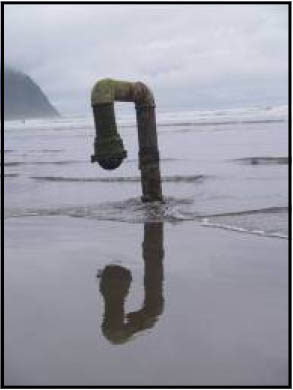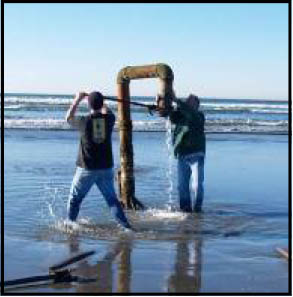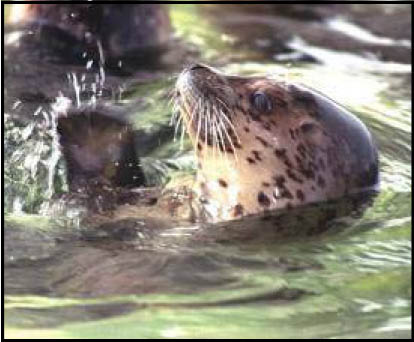|
What’s that Pipe on the Beach?
 Seen from the Prom, it could be mistaken for a clam-digger, or maybe a sea serpent
rearing its head from under the long stretch of sandy beach. It has stood there as long
as people can remember, but very few know exactly what it is. That bent-over pipe
that sticks out of the beach near the Turnaround in Seaside is actually the water-intake
pipe for the Seaside Aquarium. You could literally say this is the aquarium’s lifeline.
Seen from the Prom, it could be mistaken for a clam-digger, or maybe a sea serpent
rearing its head from under the long stretch of sandy beach. It has stood there as long
as people can remember, but very few know exactly what it is. That bent-over pipe
that sticks out of the beach near the Turnaround in Seaside is actually the water-intake
pipe for the Seaside Aquarium. You could literally say this is the aquarium’s lifeline.
Many aquariums pump water from outside to fill and aerate their tanks but most are
situated on bays where water intake pipes are covered through high and low tides.
Those aquariums have to worry about salinity changes in the bay system as the ocean
and the river struggle for control with the tides rising and lowering and the rains coming
in the winter months. The Seaside Aquarium is one of the only aquariums anywhere
that has a water-intake pipe located directly in the surf.
 There are definitely advantages and disadvantages to this situation. The Seaside
Aquarium never has to worry about salinity changes because the ocean’s salinity
changes so little. The fish in the aquarium experience the same temperature changes that they would if they were in
the wild. The pipe is exposed at low tide, so if something goes wrong, or if sand erodes away so much that the pipe
is more exposed, staff can easily get to it to make adjustments. However, the aquarium relies entirely on the tides in
this situation. If a series of weak high tides coincides with mild surf, the aquarium has a greatly reduced length of
time to pump water. The pipe is also a huge target for logs or other large items carried by the surf.
There are definitely advantages and disadvantages to this situation. The Seaside
Aquarium never has to worry about salinity changes because the ocean’s salinity
changes so little. The fish in the aquarium experience the same temperature changes that they would if they were in
the wild. The pipe is exposed at low tide, so if something goes wrong, or if sand erodes away so much that the pipe
is more exposed, staff can easily get to it to make adjustments. However, the aquarium relies entirely on the tides in
this situation. If a series of weak high tides coincides with mild surf, the aquarium has a greatly reduced length of
time to pump water. The pipe is also a huge target for logs or other large items carried by the surf.
On any typical day at the aquarium, staff discuss the subtle art of determining how
long to pump water from the surf before the pipe becomes exposed. If the pipe fills
with any air, the pump "loses the prime," effectively losing its suction ability. On the
next high tide, staff must scramble to re-initiate the suction, another process more art
than science. Although the aquarium’s circulation system is good enough that it reuses
a substantial amount of its water daily, without this single connection to the ocean,
the Seaside Aquarium could not exist.
|


